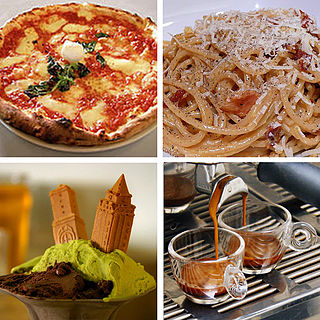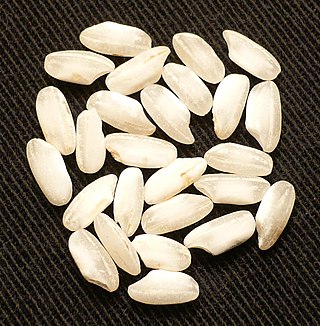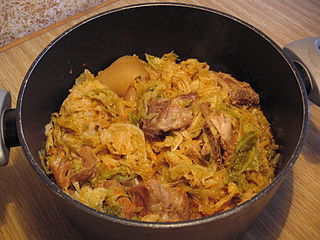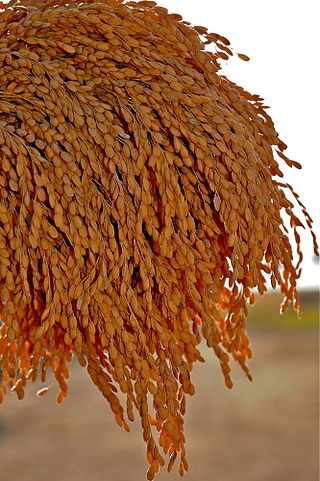
Gravy is a sauce often made from the juices of meats that run naturally during cooking and often thickened with corn starch or other thickeners for added texture. The gravy may be further coloured and flavoured with gravy salt or gravy browning or ready-made cubes. Powders can be used as a substitute for natural meat or vegetable extracts. Canned and instant gravies are also available. Gravy is commonly served with roasts, meatloaf, rice, noodles, chips (fries), mashed potatoes, or biscuits.

Carbonara is a pasta dish made with eggs, hard cheese, fatty cured pork, and black pepper. It is typical of the Lazio region of Italy. The dish took its modern form and name in the middle of the 20th century.

Scrambled eggs is a dish made from eggs stirred, whipped, or beaten together typically with salt, butter, oil, and sometimes other ingredients, and heated so that they form into curds.

Mashed potato or mashed potatoes, colloquially known as mash, is a dish made by mashing boiled or steamed potatoes, usually with added milk, butter, salt and pepper. It is generally served as a side dish to meat or vegetables. Roughly mashed potatoes are sometimes called smashed potatoes. Dehydrated instant mashed potatoes and frozen mashed potatoes are available. Mashed potatoes are an ingredient in other dishes, such as dumplings and gnocchi.

Polenta is a dish of boiled cornmeal that was historically made from other grains. The dish comes from Italy. It may be allowed to cool and solidify into a loaf that can be baked, fried, or grilled.

Pilaf, pilav or pilau is a rice dish, usually sautéed, or in some regions, a wheat dish, whose recipe usually involves cooking in stock or broth, adding spices, and other ingredients such as vegetables or meat, and employing some technique for achieving cooked grains that do not adhere to each other.

Russian cuisine is a collection of the different dishes and cooking traditions of the Russian people as well as a list of culinary products popular in Russia, with most names being known since pre-Soviet times, coming from all kinds of social circles.

Rice pudding is a dish made from rice mixed with water or milk and commonly other ingredients such as sweeteners, spices, flavourings and sometimes eggs.

Arancini, also known as arancine, are Italian rice balls that are stuffed, coated with breadcrumbs and deep-fried. They are a staple of Sicilian cuisine. The most common arancini fillings are al ragù or al sugo, filled with ragù, mozzarella or caciocavallo cheese, and often peas, and al burro or ô burru, filled with ham and mozzarella or béchamel sauce.

Ossobuco or osso buco is a specialty of Lombard cuisine of cross-cut veal shanks braised with vegetables, white wine, and broth. It is often garnished with gremolata and traditionally served with either risotto alla milanese or polenta, depending on the regional variation. The marrow in the hole in the bone, a prized delicacy, is the defining feature of the dish.

Arborio rice is an Italian short-grain rice. It is named after the town of Arborio, in the Po Valley, which is situated in the region of Piedmont in Italy. When cooked, the rounded grains are firm, creamy and chewy compared to other varieties of rice, due to their higher amylopectin starch content. It has a starchy taste and blends well with other flavours. Arborio rice is often used to make risotto; other suitable varieties include Carnaroli, Maratelli, Baldo, and Vialone Nano. Arborio rice is also usually used for rice pudding.

Italian cuisine is a Mediterranean cuisine consisting of the ingredients, recipes and cooking techniques developed in Italy since Roman times and later spread around the world together with waves of Italian diaspora. Some of these foods were imported from other cultures. Significant changes occurred with the colonization of the Americas and the introduction of potatoes, tomatoes, capsicums, maize and sugar beet—the latter introduced in quantity in the 18th century. It is one of the best-known and most appreciated gastronomies worldwide.

Carnaroli is an Italian medium-grained rice grown in the Pavia, Novara and Vercelli provinces of northern Italy. Carnaroli is used for making risotto, differing from the more common arborio rice due to its higher starch content and firmer texture, as well as having a longer grain. Carnaroli rice keeps its shape better than other forms of rice during the slow cooking required for making risotto due to its higher amylose content. It is the most widely used rice in Italian cuisine, and is highly prized.

Neapolitan cuisine has ancient historical roots that date back to the Greco-Roman period, which was enriched over the centuries by the influence of the different cultures that controlled Naples and its kingdoms, such as that of Aragon and France.

Venetian cuisine, from the city of Venice, Italy, or more widely from the region of Veneto, has a centuries-long history and differs significantly from other cuisines of northern Italy, and of neighbouring Austria and of Slavic countries, despite sharing some commonalities.

Lombard cuisine is the style of cooking in the Northern Italian region of Lombardy. The historical events of its provinces and of the diversity of its territories resulted in a varied culinary tradition. First courses in Lombard cuisine range from risottos to soups and stuffed pasta, and a large choice of second course meat or fish dishes, due to the many lakes and rivers of Lombardy.

Maratelli is a semifino rice native to the Asigliano Vercellese province of Vercelli in northern Italy. It is a stable rice genotype that maintains its features. In 1970 it covered 8% of Italian rice-cultivated fields. Maratelli rice keeps its shape better than other forms of rice during the slow cooking required for making risotto due to higher quantities of amylose.

Vialone Nano is an Italian semifino (medium-grain) rice variety. It is typical of the flat, rice-growing areas of the southern province of Verona, in Veneto.
Vialone Nano is a cultivar of the Japonica group of varieties of Oryza sativa.
Sülen are the so-called "boiled pot" dishes of ancient Mongolian cuisine. They are the most significant category of dishes attested to in the Yinshan Zhengyao (YSZY), making up 12.3% off the 219 recorded recipes of the Khan's court. The texture of dishes cooked by the boiling pot method varies from pilafs and very thick stews to soups, all the recipes in Juan 1 of the YSZY were made using the same base mutton and cardamom broth as a cooking liquid.

























